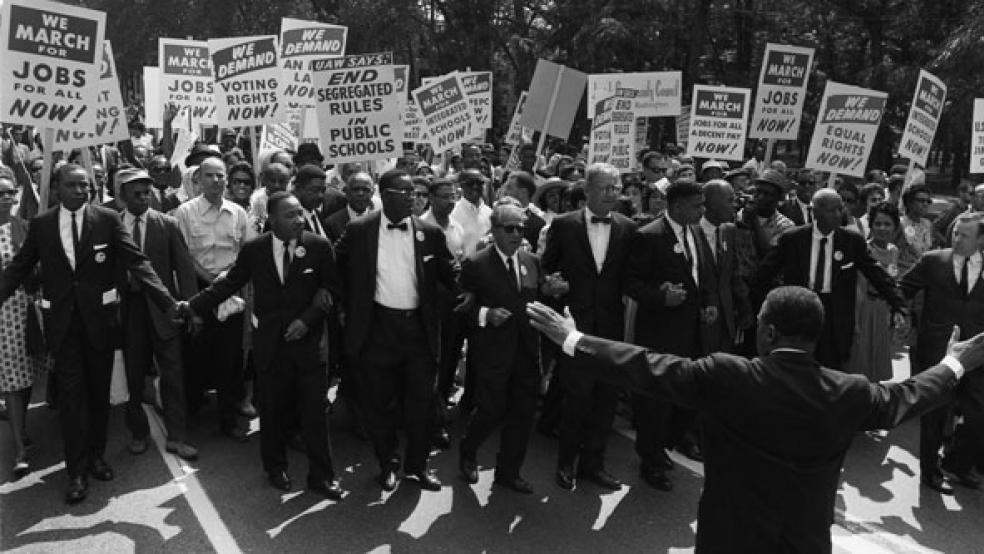The 1963 March on Washington changed politics forever, as I noted last week. In particular, it set in motion a profound political revolution, causing the two major political parties to change places in the South.
For 100 years after the Civil War, the South was the “Solid South” for the Democratic Party. Although Democrats from that region tended to be more conservative than the rest of their party, there was no way they were ever going to cast a vote for a member of the party of Abraham Lincoln.
Republicans would have been more competitive in the South except for voting restrictions that prevented the bulk of African Americans from voting despite the 15th Amendment to the Constitution. Until 1932, a majority of blacks voted Republican, overwhelmingly so for most of that period. Unfortunately, most lived in the South, where their votes essentially did not count.
RELATED: COURT STRIKES DOWN KEY PART OF VOTING RIGHTS ACT
Even after a majority of African Americans switched to the Democratic Party in 1936, in gratitude for Franklin D. Roosevelt’s efforts to provide government assistance for the poor, about a third of them remained in the Republican Party through the 1960 election.
Consequently, it was in the interest of Republicans to support voting rights for African Americans; it would have made the party more competitive in the South. That is why Dwight Eisenhower supported the Supreme Court decision desegregating the public schools in 1954 and pushed through the first civil rights legislation since Reconstruction in 1957. He did so against strong opposition from southern Democrats, including Senate Majority Leader Lyndon Johnson.
In the 1960 election, Richard Nixon sought black support and hoped for an endorsement from Dr. Martin Luther King Jr., with whom he was on friendly terms. He frequently called attention to the fact that John F. Kennedy’s running mate, Senator Johnson, was from a state of the old Confederacy and had fought civil rights legislation in Congress.
As president, Kennedy dragged his feet on civil rights, which is what led to the March on Washington. To his credit, Johnson switched sides as president and used his considerable legislative skill to pass the Civil Rights Act of 1964.
Republican support was critical to passage of the Civil Rights Act. In the House of Representatives, it would have failed without the strong support of Republicans, who provided 138 of the 290 votes for passage. In the Senate as well, Republicans votes were necessary to enact the Civil Rights Act.
Senator Barry Goldwater, Republican of Arizona, however, was among the “no” votes. He was not opposed to civil rights for African Americans, but was concerned that the Civil Rights Act was unconstitutional. This was not an unreasonable opinion because Republicans in Congress had enacted almost identical legislation in 1875 and the Supreme Court had ruled it unconstitutional. Goldwater was advised by William Rehnquist, later chief justice of the Supreme Court who was then a lawyer in Phoenix, that the Civil Rights Act of 1964 was unconstitutional for the same reasons.
I think Goldwater and Rehnquist were wrong. The decision in Brown vs. Board of Education in 1954 put the Supreme Court on a different course and the Justice Department had taken great care in drafting the Civil Rights Act to deal with potential constitutional problems. And the Supreme Court later concluded that the legislation was in fact constitutional.
RELATED: HOW THE GOP CAN WIN BACK AFRICAN AMERICAN VOTERS
Nevertheless, Goldwater’s vote had deep political consequences. The Republican share of the black vote fell from a third in 1960 to just 6 percent in 1964, from which it has never recovered. It also got him the votes of white Southerners who hadn’t voted Republican ever in their family history. As a consequence, Goldwater carried Alabama, Mississippi, Georgia, Louisiana and South Carolina—the only states he carried other than his home state.
This set in motion a political reversal in the South, which is now solidly Republican. Many liberals believe this is because Republicans pandered to southern racists. This is not correct. Republicans simply capitalized on the political opportunity that presented itself.
Although Richard Nixon is said to have pursued a “southern strategy” that appealed to whites with racial code words such as “law and order,” in truth his 1968 campaign and policies in office were not anti-civil rights. Keep in mind that Alabama Governor George Wallace of Alabama also ran for president in 1968 as an independent. He was the one pursuing the votes of disgruntled southern racists; Nixon ran as a moderate on civil rights, just as he had done in 1960. His running mate, Spiro Agnew, was widely respected for having pushed open housing as governor of Maryland.
As president, Nixon expended considerable energy and political capital in desegregating public schools, which was deeply unpopular, politically, but mandated by the federal courts. And in fact he made very considerable progress in this area. Nixon also pushed the labor unions to admit African Americans and established affirmative action.
Of course, Nixon and other Republicans pursued southern votes; they had every right to do so. But the switch of conservative Southern Democrats had more to do with deeper economic and political forces than it did with the “southern strategy.”
Economic and national security issues appealed to southern conservatives who had long belonged to the Democratic Party for historical reasons, not because of race. As the more conservative of our major parties, it was natural that they would gravitate to the GOP once the Democratic monopoly began to break down.
In the long run, the really profound development wasn’t that Republicans took over the South, but that the South took over the Republican Party. I will have more to say about this next week.





